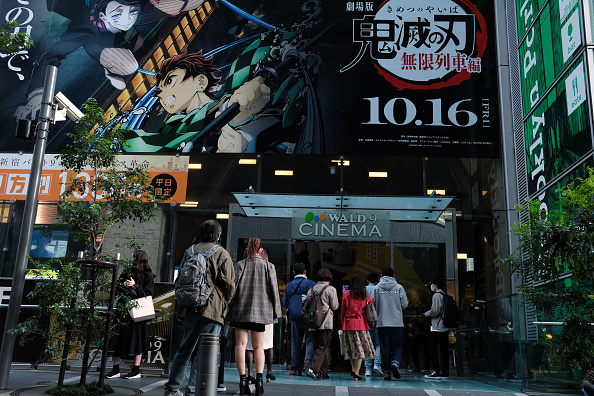Its full title is rather clunky: Demon Slayer-Kimetsu No Yaiba-the Movie: Mugen Train. Called Demon Slayer: Mugen Train for short, despite not having as evocative and sentimental a title as the artful works of Studio Ghibli the anime tie- in film unseated Miyazaki’s Spirited Away as the highest grossing box office film in Japan’s history. A tie-in to the anime series, based on the manga by Koyoharu Gotouge, the film spent 200 days in Japan’s theaters after premiering on October 16, 2020. In addition to being the highest grossing Japanese film of all time, it is also the highest grossing film of 2020 and the highest grossing animated Japanese film in the country’s history.
Rise in Popularity and Appeal
The anime, manga, and film have all become globally popular and recognizable. In the U.S., Demon Slayer candies stock the shelves of shopping mall novelty stores, Demon Slayer t-shirts sit on clothing store tshirt tables. It has become the defining shonen franchise of the nascent 2020s, and its appeal lies in its theme of resilience in the face of horror, danger, and tragedy.
These are hardly unique themes in the canon of shonen, whose boyish heroes are wont to perkily utter the phrases “Do your best!” or “Don’t give up!”, or have these phrases directed at them by a well meaning and enthusiastically nodding ally. However, in the world of Demon Slayer the stakes are higher than a quest to catch Pokemon like that of Ash Ketchum, and the terrors even more stark than those faced by Ichigo Kurosaki, the Soul Reaper hero of Bleach.
Plot, History, and Relevance
Set in turn of the 20th century Japan, Demon Slayer follows pure-hearted hero Tanjiro Kamado, the eldest child of a large and impoverished family in a mountainous village. The family’s breadwinner after the death of his father, Tanjiro returns home from trip to the village to find that his family’s homestead has been ransacked by murderous supernatural entities. The lone survivor is his sister, Nezuko, who has been transformed into a demon. Tanjiro’s mission becomes finding a cure to render Nezuko human once again. To this end, he becomes a Demon Slayer, intent on killing the demons who attacked his family.
The art of the franchise is inspired by traditional Japanese horror art, and the bloody tragedy at the piece’s center grounds Tanjiro and his quest in pathos. As the world deals with the ongoing fallout of the COVID-19 pandemic, the parallels to the horror of its pervasive onslaught and Tanjiro’s and Nezuko’s plight are incidental but clear. Like the COVID 19 virus’s first horrifying appearance in early 2020, the demons struck unexpectedly, stole the lives of Tanjiro’s family, and have left Nezuko a suffering shell of herself. With her mouth bound by a bamboo reed to quell her demonic thirst for blood, Nezuko is an emblem of silent suffering.
However, both she and Tanjiro are figures of tenacity and resolve. Just as humanity collectively settled into negotiating “the new normal” in a world that has largely re-opened and takes COVID’s influence on a day by day basis, Tanjiro settles into his quest and learns the esoteric arts of the Demon Slayers. While unable to speak to those around her, Nezuko’s voiceovers reveal her inner world: she is determined to be different than other demons, and aid humans rather than hurt them.
Impact
Hard choices, unexpected misfortune, bonds intensified by the unavoidable awareness of our mortality, and the determination to rebuild and continue our lives have become history’s portion for us, the Pandemic Generation, in the face of a slowly unfolding nightmare we wake up every day to fight our way through, as Tanjiro does a demon riddled forest, and the film’s titular Mugen Train.
The opening theme to Demon Slayer, the song “Gurenge” by Japanese singer LiSA, a blockbuster in its own right, vows, “I have found a reason to be strong.” Scenes of horror and grim circumstances are not new to anime, but the tender bond between siblings, strengthened by suffering, and Tanjiro’s determination to complete his quest resonate with the resilience the pandemic asks of us all, every day, and the love we grasp for in the face of the pandemic’s horrors.

